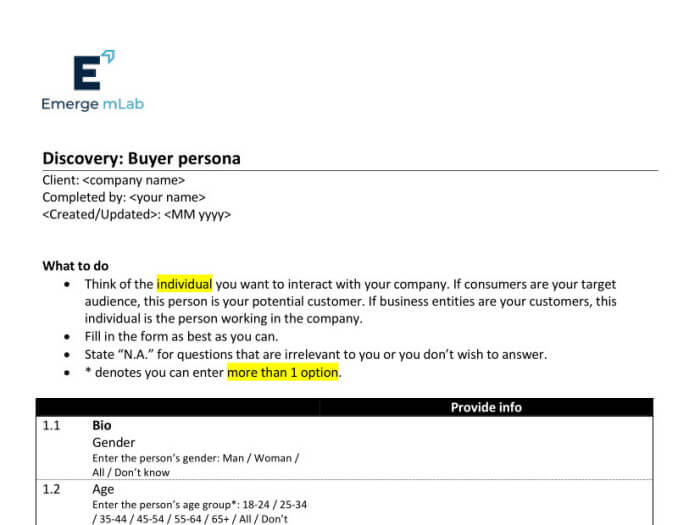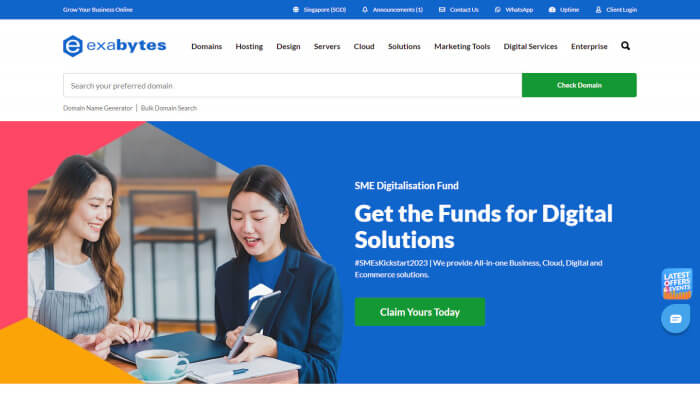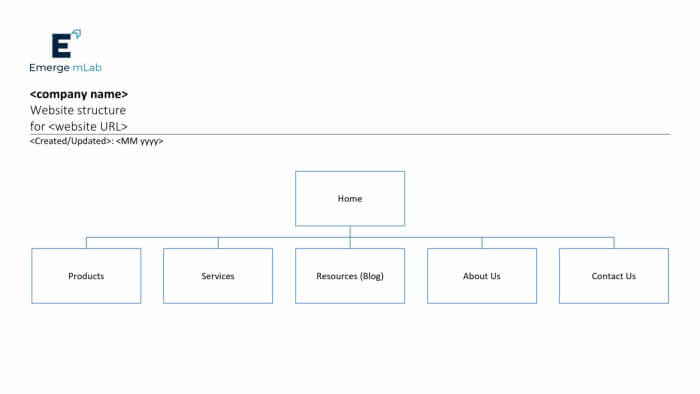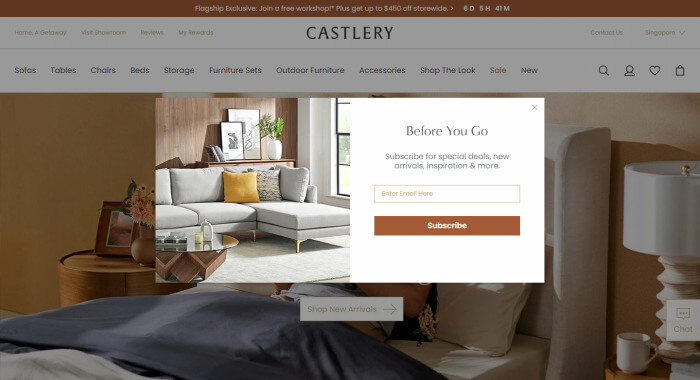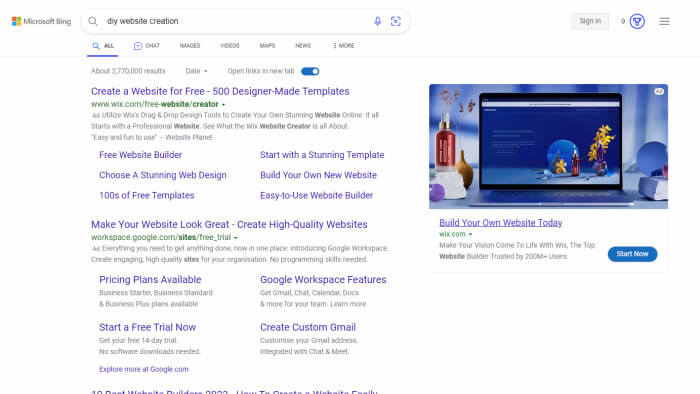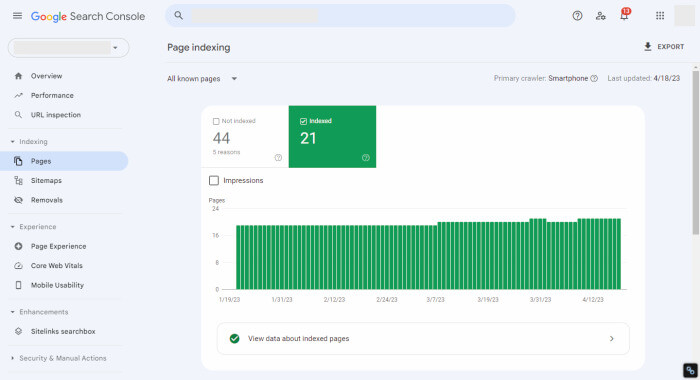A useful guide
How to create a DIY business website that impresses your customers
SEO | 15 min read
Business.com says 75% of customers admit they evaluate a company’s credibility based on its website design.
However, it’s more than simply building a pretty-looking website. Looks aside, the company website must be user-friendly and informative enough to engage visitors.
Sounds daunting for DIY web design? Not if you follow this guide.
Highlights
- We’ll take you through the creation of a business website step-by-step – from defining what you want your site to achieve, to choosing a web host and web hosting package, to planning for website development.
- You’ll find out where to get ideas for the design of your website and tips on content production.
- Learn what to do for ongoing website maintenance, a task as important as developing the website.
14-step guide to DIY business website creation
Where do I start? We advise you not to jump into construction. It’s the most time-consuming part of the process.
When you launched your business, what did you do? You planned and prepared. Same goes for website creation.
These are the actual steps Emerge mLab takes when rendering web design services:
- Determine the primary purpose of the website.
- Identify your target audience.
- Decide the domain name and register the domain.
- Choose between working with a website builder or content management system.
- Pick a web host and web hosting plan.
- Draw up a website structure and identify the web pages to be created.
- Conceive the design of the website or choose a website template.
- Decide on additional interactive components to be added.
- Select the colours and images, and create the icons to be used.
- Develop content for the web pages.
- Write page titles and descriptions for the web pages.
- Create the web pages.
- Test the website, publish it, and test some more.
- Secure and back up the website.
STEP 1
Determine the primary purpose of the website
A website generally serves 1 or more of these 3 purposes:
- Selling products and services
- Generating leads
- Establishing credentials
Once you’ve determined your website’s purpose (that has to be aligned with your sales and marketing objectives), identify your target audience, analyse the competition and define the goals the site needs to achieve.
All these will guide the type of web content developed and the deployment strategies. They’ll clarify what you want visitors to do on your website while browsing it. If there are certain things you discover your competitors have done well, don’t be shy to emulate them.
STEP 2
Identify your target audience
This is so important it deserves a step on its own.
Your target audience is made up of people most interested in your products or services. You need to know who they are and what they want, and your site has to meet their needs. Engaged visitors present business opportunities.
Understand your target market through customer data, such as demographics, spending power and behaviour, interests and pain points. Social media analytics and competitor analysis can also provide valuable insights. Tailor your marketing programmes to cater to your potential customers specifically.
Next, create a buyer’s persona. A buyer persona is a semi-fictional conceptualisation of a company’s ideal customer. You want your web content to be engaging to the individual visitor. The knowledge of the personality and characteristics of this individual will help you develop materials that appeal to your intended audience.
STEP 3
Decide the domain name and register the domain
Choosing a domain name is an essential step in creating a business website because it’s a key component of a company’s online identity and it reflects the establishment’s nature of business. To decide on the domain name, consider factors such as ease of recall, business representation, availability and so on.
After deciding on a domain name, the next step is to register it. There are many domain registrars available online, offering various categories of domains to suit a global or country-specific audience (e.g. .com vs .com.sg), organisation type (e.g. .org vs .edu) and business segment (e.g. .net vs .io). GoDaddy, Exabytes and Vodien are a few popular domain registrars in Singapore.
STEP 4
Choose between working with a website builder or a content management system
Do you want to develop your website by subscribing to a website builder or using a content management system (CMS)? Both options have advantages and disadvantages. Your choice will depend on your business’s needs, website requirements and goals, budget and technical expertise.
A website builder is a platform that allows users to create a website without any coding knowledge. Popular platforms include Wix.com, Squarespace and Shopify. It provides pre-designed templates and a drag-and-drop interface for users to design the website’s layout and content, so it requires little technical know-how to operate. However, website builders have limited customisation options.
A CMS is a software application that allows users to create, manage and publish digital content. Based on W3Techs, 43.2% of the world’s websites are developed on the WordPress CMS in 2023, far exceeding its closest competitor. The advantage of using a CMS is its flexibility of customisation. Ready-made WordPress themes are aplenty for no-code web design. However, building a website on a CMS will still require more learning, experimentation and maintenance than a website builder.
STEP 5
Pick a web host and web hosting plan
If WordPress is your preferred choice, you’ll next have to decide on a web hosting provider and web hosting plan.
A web host, such as A2 Hosting and SiteGround, is a company that provides the server/computer, network infrastructure and services needed for a website to be accessible on the Internet.
Web hosting plans are packages of services offered by a web hosting provider. The package includes server space, data transmission bandwidth, database app and other components required to house a website.
Some factors to consider when picking a web host and hosting plan include server reliability and speed, SSL security, backup, customer support and price.
STEP 6
Draw up a website structure and identify the web pages to be created
Website structure is the organisation and arrangement of web pages, content and features within a website. It determines how the website’s pages and sections are connected.
A well-structured website provides a clear and logical information hierarchy, making it easy for users to find the information they’re looking for and delve deeper into topics of interest.
So, consider business and visitor needs, content organisation and scalability, and information search and discoverability when you’re formulating the structure of your website.
STEP 7
Conceive the design of the website or choose a website template
You can opt to create a site’s look and feel from the ground up or use a theme or website template. Most DIYers go for the template approach because there are many beautiful, appropriate pre-made ones to choose from.
Either way, there are 2 design concepts you need to be aware of:
- User experience (UX). UX defines how a person feels when getting about your website. It’s important that your website visitor enjoys using the site because it can ultimately lead to a sales opportunity for your business. So, make it simple for visitors to move around your website, streamline processes in getting things done, and make sure their needs are met.
- User interface (UI). UI is the aesthetic appeal of your website. Design elements, like colours, typography and layout come into play. They should feel familiar to the visitors, elements need to be consistently applied throughout the site so that users know how to operate components intuitively. The layout has to be balanced, uncluttered.
If you’re taking up the challenge of designing from scratch, start with wireframing. This technique involves drawing the layout of the elements, including content, to be placed on a web page and how pages interact with one another either on paper or digitally – usually without actual content and colours.
Short on design ideas? Here are some places to get your Eureka moments:
- Design galleries. View professional web designers’ work at sites such as Dribbble, Behance or Awwwards.
- Themes and website template sales websites. Marketplaces like Envato Market and Divi Marketplace provide numerous references.
- Web design portfolios. Digital marketing agencies showcase their best works. Go through their portfolio to check out what they had done for their clients.
- Leading competitors. See what features they’ve incorporated into their websites, and think of what you can do differently to serve your customers even better.
- Your customers. Ask your customers for their wish list – you may uncover some invaluable insights.
- Your team. Who knows? There might be a design aspirant not yet discovered!
Think through UX carefully and apply attractive UI in the designing of your website and you would gain repeat visits from your prospective customers.
STEP 8
Decide on additional interactive components to be added
Have an announcement to make? Want to grow your email list? Offering a special discount to visitors of your website? There are components, such as online form, notification bar, pop-up and newsletter sign-up, that you can add to your website.
You’ll need to balance functionality and web page loading speed though. The more interstitials you cramp into a page, the more distractions there are, and this can annoy visitors. It’ll also take a page longer to appear, frustrating impatient information searchers.
Using a CMS for web development would allow you to incorporate these components into your website because of its versatility. However, a website builder may not have such capability. That’s another evaluation criterion for web design tool selection to keep in mind.
STEP 9
Select the colours and images, and create the icons to be used
Want a visually appealing and engaging business website? Pay attention to the choice of colours, images and icons.
Colours evoke different emotions and can impact user engagement. For example, blue conveys a sense of trust and professionalism, while red invokes urgency or passion. Choose colours that align with your brand and resonate with your audience. Make sure they’re cohesive.
Use high-quality and relevant visuals that complement the content and enhance the user experience. The images should also align with the brand’s tone and voice. If budget permits, commission a professional photographer to take photos of your business in action – authenticity is a huge plus point.
Icons should be simple, recognisable and consistent with the brand’s visual element.
STEP 10
Develop content for the web pages
We can’t emphasise enough the importance of good quality content.
Identify your prospective customer’s purchasing journey (or buying cycle) and create appropriate content – use text, infographics, video or audio depending on the audience’s preference – that aligns with each stage of the journey.
Ensure the content is consistent with your brand’s voice and tone and is error-free -important because your prospects use little things like this to gauge the quality of your service.
Besides greater user engagement, quality content also positively affects your site’s organic search engine ranking.
STEP 11
Write page titles and descriptions for the web pages
The page title (also called “meta title” or “title tag”) of a web page helps both users and search engines understand the content of the page. It’s a concise description that appears at the top of the browser window or tab. It’s also displayed on search engine results pages (SERPs) and includes a link users can click to visit the page.
3 tips for writing a good page title:
- Keep it short.
- Be descriptive, explain the purpose of the page.
- Include the primary keyword of the web page to make it easy for search engines to understand the page’s content.
Page description or meta description is an HTML tag summarising the content on a web page. It usually appears below the page title in SERPs, providing a brief overview of what the user can expect to find on the page.
The goal of the meta description is to encourage users of a search engine to click through to the page. A good meta description provides a clear and engaging summary of the content on the web page, but get straight to the point (keep your writing to 160 characters or fewer). Include the primary keyword of the page to indicate it’s relevant to search queries.
STEP 12
Create the web pages
Now that you’ve completed steps 1-11, it’s time to create the pages of your website.
The essential thing to take note of at this stage is to make sure your pages look good, not just in desktop view but also on mobile devices. According to Statista Digital Marketing Insights, close to 89% of Singaporeans use mobile internet in 2020 and projected to be more than 94% in 2026.
Almost all website builders and website templates cater to mobile website layouts these days.
STEP 13
Test the website, publish it, and test some more
Finally, time to show off your new website!
Once it’s published, ask your employees, friends and relatives to “stress test” your website and let you know if they spot any typo mistakes, unclickable buttons or links, erroneous forms, etc. Ask them for feedback on navigation, UI on both desktop and mobile devices, and content readability. Make a list of changes to be done and rectify them.
Ensure your website can be crawled by search bots. Search engines would index your site only if it’s crawlable. You can use the Robots.txt Test tool at SEO Site Checkup to run a test.
STEP 14
Secure and back up the website
One last step…
Protect your site from cyber threats. There are a few ways to do it:
- Use a strong login passwordand implement two-factor authentication to prevent hacking.
- Apply SSL certificate to your site to establish secure connections.
- For WordPress website, use a security pluginlike “Wordfence Security” and “All-in-One Security” for added protection. Remove plugins and themes that are not used from the system and regularly update those that are in use.
- Tap a content delivery network (CDN), such as Cloudflare, to pre-empt distributed denial-of-service (DDoS) attacks.
Once your website is finalised, run a full backup of the site and keep the backup file in a safe place. By doing so, you have a “clean” version of your website that you can restore in case of a mishap.
Also, make sure your web hosting service provider or website builder platform regularly performs backups of your site.
If you’re concerned about downtime, subscribe to a website monitoring service. UptimeRobot offers such a service free-of-charge to give you peace of mind.
How to maintain your website
Almost 8 out of 10 customers would stop going through the content on a web page if it doesn’t display properly on their device.
Glitches can develop on your website over time – conflicting plug-ins can cause a WordPress site to crash, for example. Like the aircon system in your house, your website needs regular maintenance too.
Here’s what to do every 1-3 months:
- Check if the website still appears and functions normally.
- Update website templatesand plugins to address inherent bugs and security issues.
- If the content is outdated or links are broken, make appropriate amendments.
- Find out whether the backup continues to work properly. If changes have been made to the website, run a new full backup.
FAQ
How long does it take to create a business website?
The time it takes to create a business website vary depending on factors such as the complexity of the design, amount of content and type of functionality required. A professional website designer should be able to create a basic website within 2-4 weeks.
What should you include on your website?
A business website should include essential information about the company, such as the company’s history and mission, products or services offered, contact information and operating hours, and any relevant legal information. It should also be visually appealing, easy to navigate, and optimised for search engines.
Should I build my website or pay someone else to do it?
Whether to build your website or hire someone to do it depends on your technical expertise, time constraints and budget. While creating a website yourself using website builders or content management systems like WordPress is possible, hiring a professional can save you time and ensure a more polished result.
How much does a website cost to make?
The cost of creating a website vary with design requirements (e.g. animation, photograghy), content creation (e.g. video, infographics) and functionality (e.g. inclusion of polls, calculators). A basic website can cost as little as a few hundred dollars, while a more complex site tens of thousands of dollars. Find out more from our pricing guide.
How much does it cost to upgrade a website?
The cost of upgrading a website depends on the changes needed. Minor updates and tweaks may be inexpensive, while a major redesign or overhaul can cost thousands of dollars.
Is it possible to make a free website?
Creating a free website using website builders such as Weebly or Webflow is possible. However, these free options typically have design, functionality and branding constraints. For example, your site can only use a subdomain (e.g. yourdomain.wixsite.com) instead of your own (e.g. yourdomain.com), or you may be obliged to display ads pushed from them.
Juliet H
Content creation & web design
Writer for several online publications including Expedia, Finder SG and The Peak. Worked as a copywriter for Seattle-based National Film Festival for Talented Youth. NUS Communications and New Media graduate.

Kirby Poh
Search marketing & web design
Spent years marketing and selling to SME customers in Southeast Asia – he knows B2B marketing. Gets a kick out of using his SEO and PPC ad abilities to make money for Emerge mLab’s clients.
Build (or rebuild) your business website on a strong foundation
Website structure matters, encouraging visitors to easily find relevant information. Do you know what they want?
Constructing these structures is our forte.
Let us know if you would like one created for you. Complete the form.
After we learn more about your business and industry, we’ll email you a recommended site structure - free of charge. You can take this tailored “blueprint for success” to any web developer, even if you don’t choose us. We’re glad to bring value to your company.
Sample a business website structure report (valued at $225)
Please hurry, we accept only 10 requests each month.
Note: Emerge mLab reserves the right, at our sole discretion, to refuse to provide this service to any person or business for any or no reason.
Hi, I’m Annie!
If you wish to speak with a person at Emerge mLab, just tap the call or WhatsApp button – I’d likely be the one picking up your call.
Otherwise, go to our “Contact Us” page to reach us in other ways.
Monday-Friday: 9 a.m.-6 p.m.
Emerge mLab
Equips businesses with powerful online lead generation capabilities
Web design guides
How to create a DIY business website that impresses your customers
Why your business’ website has become even more important than you think
Revealed: 6 of the best website design companies in Singapore for small businesses
Ultimate guide to website design prices for SMEs in Singapore

